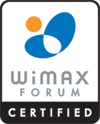
Power Saving Mechanisms
Mobile subscriber terminals must be small and light in order to be carried conveniently. To preserve the limited battery-life in such terminals, mobile WiMAX standard specifies mechanisms to ensure the mobile stations are not active when no data is being sent/received from the base station. The base station scheduler can switch the terminals to and from Active, Idle, Sleep and Inactive modes depending on activity levels.
- Active State
- -MS requests BS to enter sleep mode to save power
- -Sleep mode 'start frame' is indicated
- Sleep State
- -MS sleeps for integer # of frames called sleep interval
- -No MS Tx or Rx during this interval
- -Power saving classes supported provide flexible wake up methods
- Listen State
- -MS Listens for integer number of frames called listening interval
- -Paging detected in this interval
- -If Data traffic waiting on BS it is indicated
- Idle Mode
- -MS uses special mode called "Idle mode" to receive broadcast/multicast service without registration at specific BS
- -DL traffic received but no UL Tx within broadcast region
- -Paging controller (in the network) co-ordinates DL traffic and paging groups
PacketMAX systems support both open loop and closed loop power management for greater flexibility.


